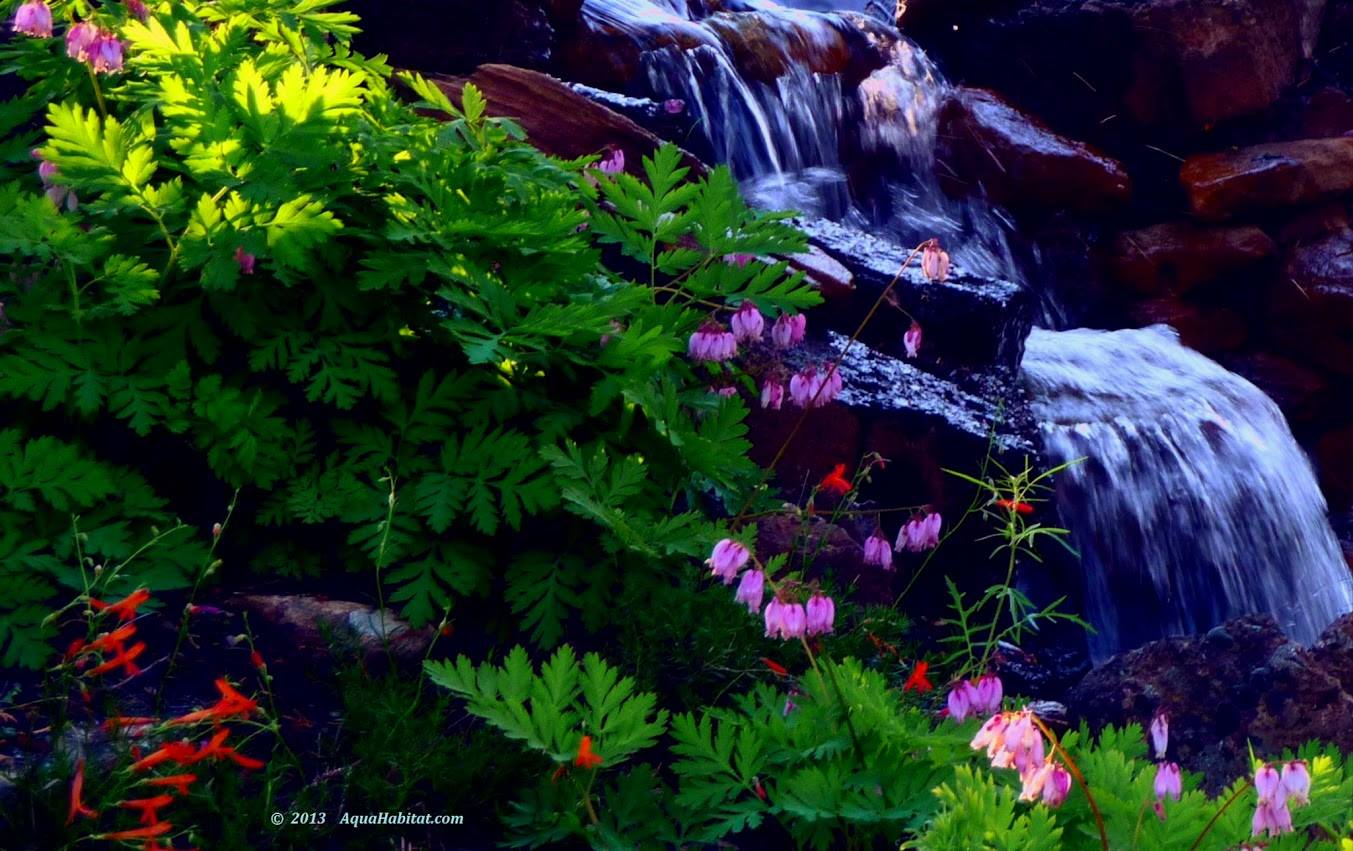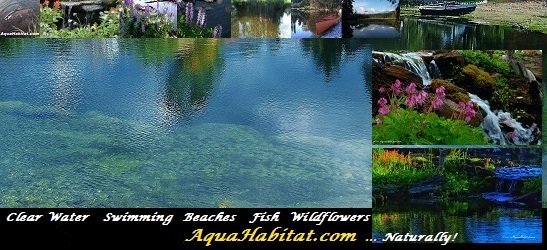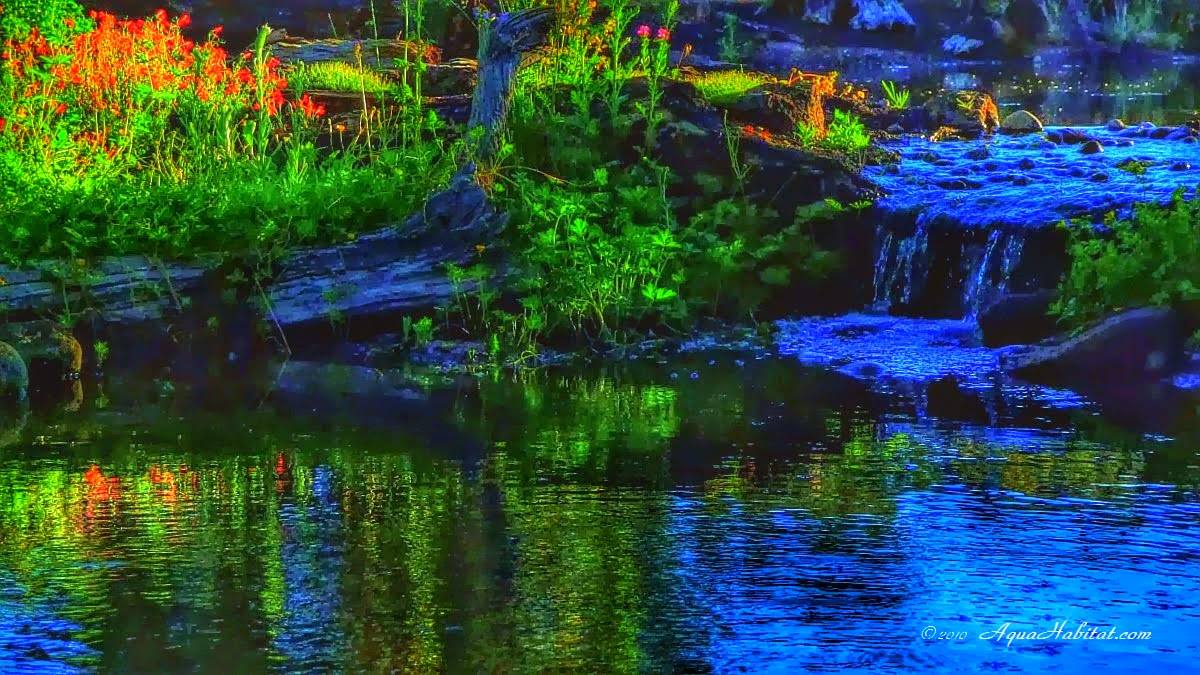Wildflowers and native plants in natural landscaping gardens ponds streams & lakes
Native plants and wildflowers make natural landscaping self sustaining and beautiful around Ponds &lakes. Natural landscape design help /w biologist produces stunning gardens with low maintenance & costs. Native landscape Pond design construction & planning or building or digging /w help by biologists.topics: natural landscape designers should be biologists. Subjects: natural landscaping tips ideas + help & assistance by Biologists At Spring Creek we are professional biologists specializing in natural landscape design, so construction costs are minimal
Wildflowers & Native Plants in Natural Landscaping
 |

Lake Pond and Stream • Planning • Design • Construction • Management |
|
For every page "Like", we plant a wildflower on a lake or pond (see here) Follow us for seasonal advice.

Much Ado about Wildflowers in Natural Landscapes

|

All over the internet we see volumes written about why we should use native plants. We are emplored to save water, help wildlife that depends on native plants and to avoid noxious species that harm our environment. All of these issues are real and true, but rarely do the statements go beyond you should do this or that. We are here to tell you you just might fall in love with native flowers and vegetation for another reason: because they can be more attractive and satisfying than other forms of vegetation. You just might end up actually wanting to use natives after we make a few suggestions.
Native wildflowers are rarely the biggest and brightest flowers you have seen. A huge industry exists to pump up the volume and create the next brilliant domestic variety of flowers. Nature isn't interested in sales, so it evolves for other reasons that have to do with the entire habitat of the plants. So how do we even suggest you adopt natives over those brilliant domestics? It is all about the place, the feeling and the story being told by native plantings.
In our travels we notice that most landscaping and flower gardens are just a place to show off the blossoms and interesting vegetation. The plants are the focus instead of the place. Yes, colorful flowers are attractive; yet they are just flowers. What emotion does a flower garden deliver other than attractive vegetation? Sure, they are colorful and happy places, but what more could or should they be? We ask this question even to highly designed garden designs.
The problem we see with most displays of native wildflowers in gardens is the gardens are still designed for showy domestic blossoms instead of the natives. Typical gardens actually look boring when they attempt to shove natives into them. It’s not a wonder people don’t get enthused for native wildflowers in these cases. Gardeners need to create the proper context if they want to promote native plants.
The opportunity a landscape has with native vegetation is only partly about the plants. The rest of the story is about the PLACE. We get to recreate special places instead of simply more flowers when we use natives. In our work designing streams, ponds and lakes is also about designing a place. That place may be a mountain lake or brook. It may be a forest stream. It is always a place instead of just water, plants and fish. So why are these places important? It is because they remind us of places we love that rarely exist in our home landscape. They are places we love to be, but have to travel to enjoy. They are the places we get to visit two weeks of the year while we dream of them the other fifty weeks. They are the places we WANT to be, but just can't find a way to be there all the time usually because we have responsibilities of life with which to contend.
You may be thinking we just want to enthrall you with the idea of a trout stream or lake in your back yard. Well, yes we do for those who wish to invest, but what we really want to do today is show you that with a hand full of old limbs, logs, rocks etc, you can truly find great satisfaction in native landscapes with barely any extra investment.
It does not require a grand effort to enjoy natives. The great news is size is not important. Emotion is the goal. While we do find great satisfaction in creating fishing lakes with streams large enough to fish and float, we have also profoundly noticed a two-foot square natural setting in the lawn or on the deck also provides us a very relaxing natural setting to unwind after work, or even at lunch. A very natural tiny natural place can provide so much of the soothing mental relief that is the basis of a new discipline coined ecopsychology. It is something better experienced than described. We will just tell you we are probably the most critical judges of landscapes because we spend our careers out in gorgeous wild places. The way we experienced this phenomenon was from sitting on a deck with a tiny experimental waterfall we are working on. Just sitting next to that tiny patch of flowers and watching and hearing the falling water had a shockingly soothing effect that we had only experienced out in the wilds before that particular day.
That waterfall represents a place - actually many places that we love. To anyone who has enjoyed a walk in a forest or next to a stream or a wildflower meadow, these often become special places we want to experience many times. While recreating such places may be impracticle at home, we can all still enjoy vignettes of those grand settings. In a larger scale, it may have been the large trees or lakes that bekoned us to travel, but we also notice the wild flowers, the pine cones, the smaller shrubs that lend color and texture to those wild places. These are the elements that let us create that wild place at home And emotionally what we tend to want to see are those same sorts of plants - the native plants. Again, domestic plants are beautiful, but emotionally we want that recreation of place to look like, or at least suggest, those wild places we travel far to experience. More simply, just close your eyes or reach for a scenic calendar; you will suddently see the wild places we have in mind.
Now you can go look at our photo gallery and see some wonderful examples of some elaborate special places we have designed, but we want to extole the virtues of natives for all budgets. The images below are of one of our test plots we use to learn the subtleties of difficult plants. We chose this particular spot because it only had one small flower blooming. We wanted to portray the effect on a very pedestrian setting instead of something in full bloom. We went out and found an old willow limb and a pine cone to illustrate the native places’ effect.
What do you think of the difference in the two photos? To us, one of them looks like a bunch of boring plants, yet the other seems to be a sunny spot out in the forest. Again we only used one limb and one pine cone. We could have gone to greater effort and used a moss covered boulder or some old tree snag, but we wanted to show what could be done with the simple investment of bending over and picking up a limb and a pine cone. While it is very tempted to add a beautiful mossy boulder to this picture to make it more appealing, we wanted to keep it extremely simple and let the readers' imagination take control.

A wildflower test plot out in the forest

A wildflower in a test plot
It is is our belief that there are millions of people who will enjoy wildflowers and native plants once they understand how to use them to create a special place they will love. We don't need to be told what we should do; we can simply be shown what we can enjoy. This is what we do.
Now when we add all the “magic” elements together we get the photo at the top of this article. Notice we selected an image with just a few small wildflowers, but they make a very big impact to the emotional beauty of the setting.
A side benefit of creating a natural setting is the garden will remain beautiful without the explosion of color of annuals. This allows for less maintenance since the garden, which has now become a habitat will remain beautiful with fewer blossoms.
When we take the natural habitat setting to its full expression with many natural elements, something like this happens:

Natural garden habitats where flowers, rocks and trees come together to create natural settings
There are many other examples on our photos tab on Facebook. Our very best pond and lake photo gallery can be seen on Google+
For more articles like this, follow our collections on Google+ where we cover a wide range of topics from waterfront real estate investing , natural gardens, our travels as Biologists, fishing, and building ponds and lakes in a much better organized format.
By the way, some people seem to have difficulty with a private company going around creating and improving habitats for native flora and fauna. They tend to think non-profits are suppose to fill this role. The reality is we create more valuable habitat on private lands owned by people who privately fund these habitats than anyone. Readers can actually assist in creating native habitats via their likes. follows and shares on social media without spending a penny. Those who share this message will also make native habitats much more popular than what we are seeing across the land today. We do not need to build every habitat, but we do want to see natural become more popular for everyone’s sake.
The more people who see these messages, the more habitat we will eventually create for more native species of plants, fish and wildlife. Yes we will make a profit as a reward for dedicating our careers to this cause. Guess where that profit will go... it will create even more habitat.
Link to us
If you find this information valuable, then help us spread our message by suggesting other sites involved with aquatic conservation issues link to Spring Creek.
If you "like", others may benefit from this information.
FURTHER READING...
- Our best Photo Gallery of our ponds, lakes and streams on Google Photos
- Visit our discussion on Facebook.
- Continue your pond or lake planning process.
- Valuable insights on sealing a pond or pond liners Our thoughts may be surprising
- Learn the finer points of waterfront real estate in waterfront property buyer's guide
- Save sensitive species of fish, wildlife and wildflowers on your own private refuge habitat. Our private refuge program for rare and sensitive species
- All about Building a natural pond / lake to prevent mosquitoes
|
Click "like" to see our natural waters on facebook or +1 us on Google+ |
We look forward to discussing bringing your water to life!
| Home | Planning Guide | Ponderings | Fish Myths | Trout Tips | FAQs | Resources | Property | Gallery |
Contact Spring Creek

Spring Creek Aquatic Concepts
Lake Placid, NY Portland, OR Bend, OR
Vancouver BC Canada Estes Park Colorado - spring 2010
(971) 266 4669
© 1999 - Spring Creek Aquatic Concepts
No part of this material may be reprinted without permission of Spring Creek Aquatic Concepts.